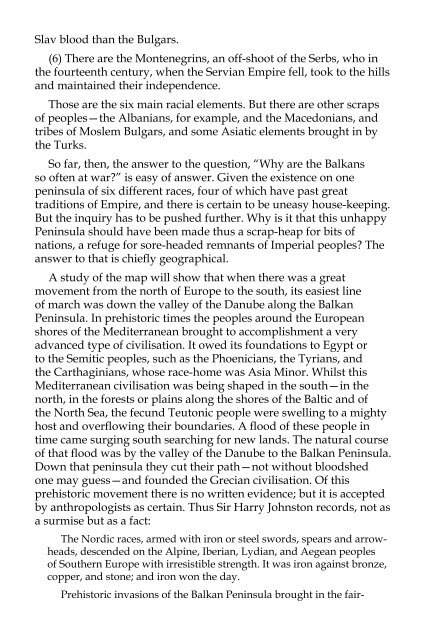Bulgaria e-book - iMedia
Bulgaria e-book - iMedia
Bulgaria e-book - iMedia
Create successful ePaper yourself
Turn your PDF publications into a flip-book with our unique Google optimized e-Paper software.
Slav blood than the Bulgars.<br />
(6) There are the Montenegrins, an off-shoot of the Serbs, who in<br />
the fourteenth century, when the Servian Empire fell, took to the hills<br />
and maintained their independence.<br />
Those are the six main racial elements. But there are other scraps<br />
of peoples—the Albanians, for example, and the Macedonians, and<br />
tribes of Moslem Bulgars, and some Asiatic elements brought in by<br />
the Turks.<br />
So far, then, the answer to the question, “Why are the Balkans<br />
so often at war?” is easy of answer. Given the existence on one<br />
peninsula of six different races, four of which have past great<br />
traditions of Empire, and there is certain to be uneasy house-keeping.<br />
But the inquiry has to be pushed further. Why is it that this unhappy<br />
Peninsula should have been made thus a scrap-heap for bits of<br />
nations, a refuge for sore-headed remnants of Imperial peoples? The<br />
answer to that is chiefly geographical.<br />
A study of the map will show that when there was a great<br />
movement from the north of Europe to the south, its easiest line<br />
of march was down the valley of the Danube along the Balkan<br />
Peninsula. In prehistoric times the peoples around the European<br />
shores of the Mediterranean brought to accomplishment a very<br />
advanced type of civilisation. It owed its foundations to Egypt or<br />
to the Semitic peoples, such as the Phoenicians, the Tyrians, and<br />
the Carthaginians, whose race-home was Asia Minor. Whilst this<br />
Mediterranean civilisation was being shaped in the south—in the<br />
north, in the forests or plains along the shores of the Baltic and of<br />
the North Sea, the fecund Teutonic people were swelling to a mighty<br />
host and overflowing their boundaries. A flood of these people in<br />
time came surging south searching for new lands. The natural course<br />
of that flood was by the valley of the Danube to the Balkan Peninsula.<br />
Down that peninsula they cut their path—not without bloodshed<br />
one may guess—and founded the Grecian civilisation. Of this<br />
prehistoric movement there is no written evidence; but it is accepted<br />
by anthropologists as certain. Thus Sir Harry Johnston records, not as<br />
a surmise but as a fact:<br />
The Nordic races, armed with iron or steel swords, spears and arrowheads,<br />
descended on the Alpine, Iberian, Lydian, and Aegean peoples<br />
of Southern Europe with irresistible strength. It was iron against bronze,<br />
copper, and stone; and iron won the day.<br />
Prehistoric invasions of the Balkan Peninsula brought in the fair-<br />
haired, blue-eyed Greeks, the semi-barbarian conquerors of the<br />
Mukenaian and Minôan kingdoms. Tribes nearly allied to the Ancient<br />
Greeks diverged from them in Illyria, invaded the Italian Peninsula, and<br />
became the ancestors of the Sabines, Oscans, Latins, etc.<br />
The parent ancestral speech of the German tribes about four to five<br />
thousand years ago was probably closely approximated in syntax, and<br />
in the form and pronunciation of words, to the other progenitors of<br />
European Aryan languages, especially the Lithuanian, Slav, Greek, and<br />
Italic dialects. Keltic speech was perhaps a little more different owing to<br />
its absorption of non-Aryan elements; but if we can judge of prehistoric<br />
German from what its eastern sister, the Gothic language, was like as late<br />
as the fifth century B.C., we can, without too much straining of facts, say<br />
that the prehistoric Greeks, when they passed across Hungary into the<br />
mountainous regions of the Balkans, and equally the early Italic invaders<br />
of Italy, were simply another branch of the Teutonic peoples later in<br />
separation than the Kelts, with whom, however, both the Italic and the<br />
Hellenic tribes were much interwoven.... Very English or German in<br />
physiognomy were most of the notabilities in the palmy days of Greece,<br />
to judge by their portrait-busts and the types of male and female beauty<br />
most in favour—as far south as Cyprus—in the periods when Greek art<br />
had become realistic and was released from the influence of an Aegean<br />
standard of beauty.<br />
Sistov, on the Danube





